
We now have three rare MME sets on display, in colour-printed tinplate boxes. Mechanics Made Easy was the construction set system invented by Frank Hornby in 1901, that acquired the more memorable name Meccano in around 1908. Meccano Ltd. went on to become the world’s biggest toy company, and Hornby went on to create Hornby Trains, Hornby Dublo, and Dinky Toys.
Blurring the lines between toys, and models, and real things that are just really, really small, the museum’s lobby will be displaying Alex Orchin’s Peel P50, the world’s smallest production car, for the next six months.
The teensy car’s arrival was featured on Danny Pike’s show on BBC Radio Sussex, and was shown on BBC South East Today Evening News (it’s at the end of the segment).
Our seasonal display of snowy Christmas/Winter Lego sets is now back on show.
Lego fans might be interested to know that the flashing lights on the Christmas tree are wireless LEDs inside standard clear Lego bricks. The tiny stand-alone LEDs each have their own built-in power receivers, using the same induction-coil technology as wireless mobile phone chargers.
We now have a new banner across the bridge at the top of Trafalgar Street, to tell people where we are. It replaces the older one that was vandalised earlier this year.
The new one has been made possible by generous help from Brighton Bricks and Southern Rail UK.

Things will be a little quiet on the “display updates” front for the next few months, as most of our efforts between now and the end of the year (and maybe into January) will be spent on preparing a new non-public workspace for the use of inventory volunteers.
We’ll be scraping and treating walls, recladding, levelling floors, woodworking, repainting pretty much everything, and generally reorganising.
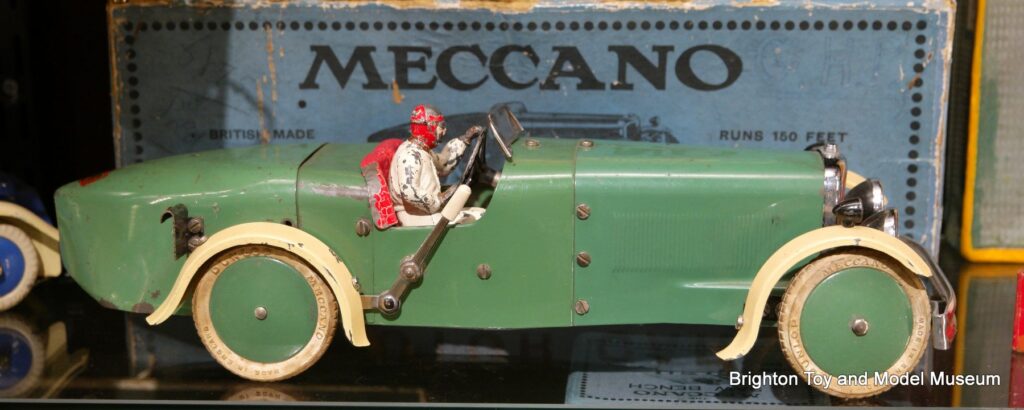
From 1932 onwards, Meccano Ltd. produced dedicated ranges of Motor Car Constructor and Aeroplane Constructor kits. The car kits were nicely enamelled, had their own clockwork motors and steering, and came in a range of four colour schemes and two sizes. Since they were slightly fiddly to make, the company could also supply the main designs ready-built. This is a boxed, factory-prebuilt example using parts from the No.2 Outfit. These sets weren’t produced again after World War Two.

The tradition of 1:72 plastic model aircraft kits didn’t start with Airfix, but with a company called International Model Aircraft, and their brandname FROG. IMA were partly owned by Tri-ang, and operated out of their Merton factory, using the central football field to test their flying aircraft models. The logo for these models was a winged frog, representing the acronym Flies Right Off Ground (i.e. no launcher required).
IMA then bought a plastic injection moulding machine to make their propellers (because wooden ones kept breaking), and once they had the machine, starting casting around for other things to use it for. After playing with some of the 1:72 Skybirds wood-and-metal model aircraft kits, they decided to try making something similar in plastic, and a new genre was born. Since the new models didn’t fly, IMA invented a sub-brand named after a non-flying bird, making them FROG Penguins – possibly the toy industry’s most confusing brand-name ever.
Work continues on the new aviation cabinet, labelling and interpretation will continue to improve over the next few months.

The Skybirds range of wooden aircraft kits, distributed by London-based A.J. Holladay & Co. Ltd., pioneered the use of 1:72 as a standard scale for aircraft models. The range was the brainchild of the absurdly talented aircraft modeller, illustrator and journalist James Hay Stevens (1913-1973), who launched the range in 1932 when he was only eighteen or nineteen years old. Skybirds “rode the wave” of the rise of British aviation in the ‘Thirties , and as new types of Art Deco airport and aerodrome building, and new support vehicles and infrastructure started to appear at the exciting new civilian aerodrome facilities at Brooklands, Heston Air Park and Gatwick, Skybirds produced corresponding models.
Skybirds became a phenomenon, with local clubs and newsletters and competitions, and as World War Two loomed, the Skybirds network was used to recruit for the RAF.

Britains Ltd. were originally best known for their toy soldiers, and after WW1 for their 1:32 scale farm animals, zoo animals, circus figures and garden sets. A lesser-known episode in the history of Britains was their production in the 1930s of lead-and-tinplate 1:32 aeroplanes and accessories, including anti-aircraft personnel. The most desirable items in this range were probably the Barrage Balloon and Lorry sets, consisting of a large suspendable Barrage Balloon and its lorry and winch.
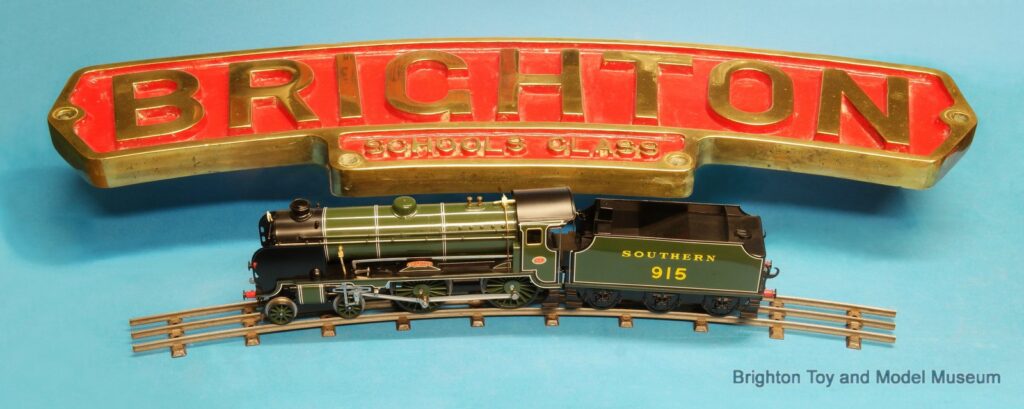
The Southern Railway 4-4-0 “Schools Class” steam locomotive number 915 was named “Brighton” after Brighton College.
Southern are thought to have created three cast-brass “Brighton” loco nameplates for it: two for the loco and one to be donated to the school. One of these three was owned by beloved Brighton photographer and photojournalist legend Roger Bamber, who recently passed. He left it to us, and we will be proudly putting it up in the museum some time in April.
Brighton Museum and Art Gallery‘s special exhibition of Roger’s works, “Out of the Ordinary” opens on 1st April.
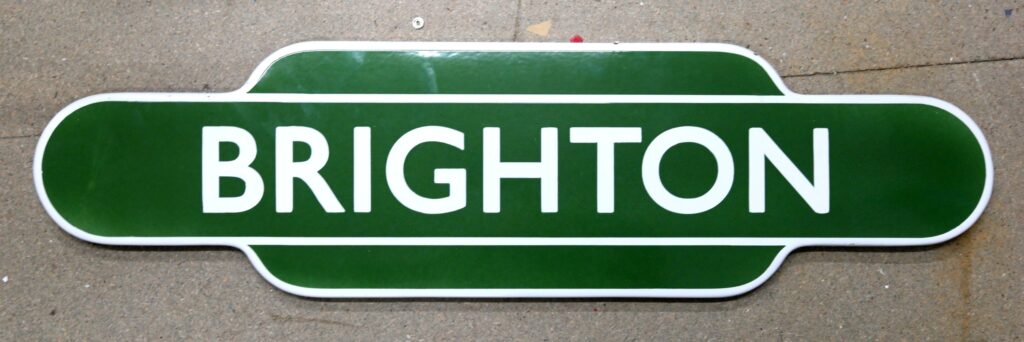
We used to regularly get asked why the old enamelled steel railway station sign over the shop counter said “SELHURST” rather than “BRIGHTON”. The simple reason was that we didn’t have one that said “Brighton”. Now we do. This one’s a repro, but it’s still pretty authentic.
We are now trialling our new Audio Guide!
Developed by Enhanced Experience, the guide has many minutes of professional audio outlining special stories around the museum, and costs £3.50

Something that everybody can be part of! For five pounds you can get hold of one of these lovely new enamelled metal badges to support the Trafalgar Street Regeneration Project.
Available now through the Museum Shop.
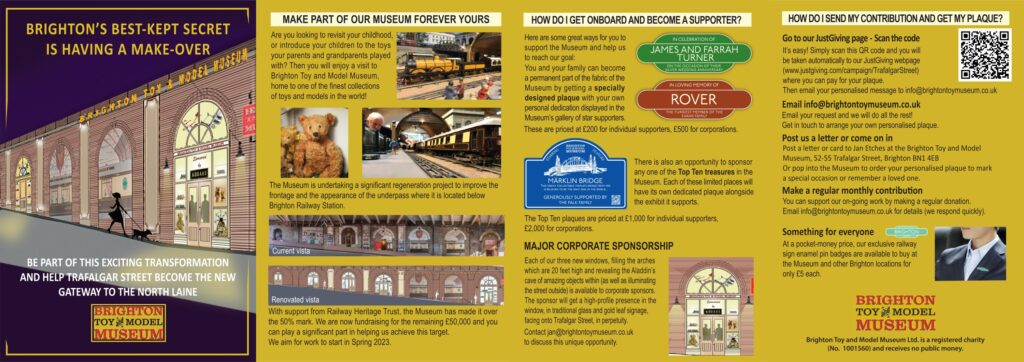
The Regeneration Project now has its own fundraising leaflet (.pdf), listing all the various sponsorship options.
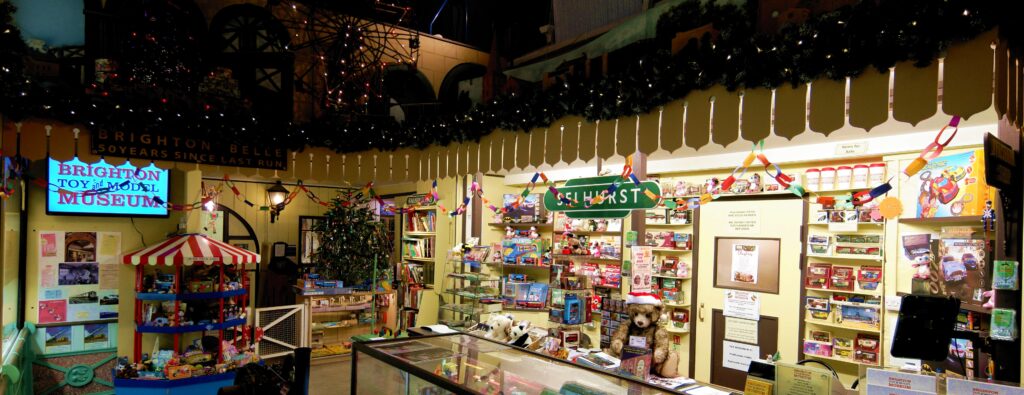
Unusually for us, we’ll be open during Christmas Week this year, with some restrictions (although we’re closed on Christmas Eve). As a result, we’ve decided to supplement the usual second-hand Collectors’ Market items with some brand new modern “Hornby Hobbies” stock, including a limited number of Hornby trains, Airfix kits and Scalextric (and Micro-Scalextric) sets, and some Corgi “Chitty Chitty Bang-Bang” cars.

New on display, a recently donated Ubilda Tower Bridge set 65-60 with quite lovely printing.
The Ubilda series (1928 onwards) were printed tinplate toys that added extra play value and widened their appeal by including a self-assembly element, so that they were also construction toys.
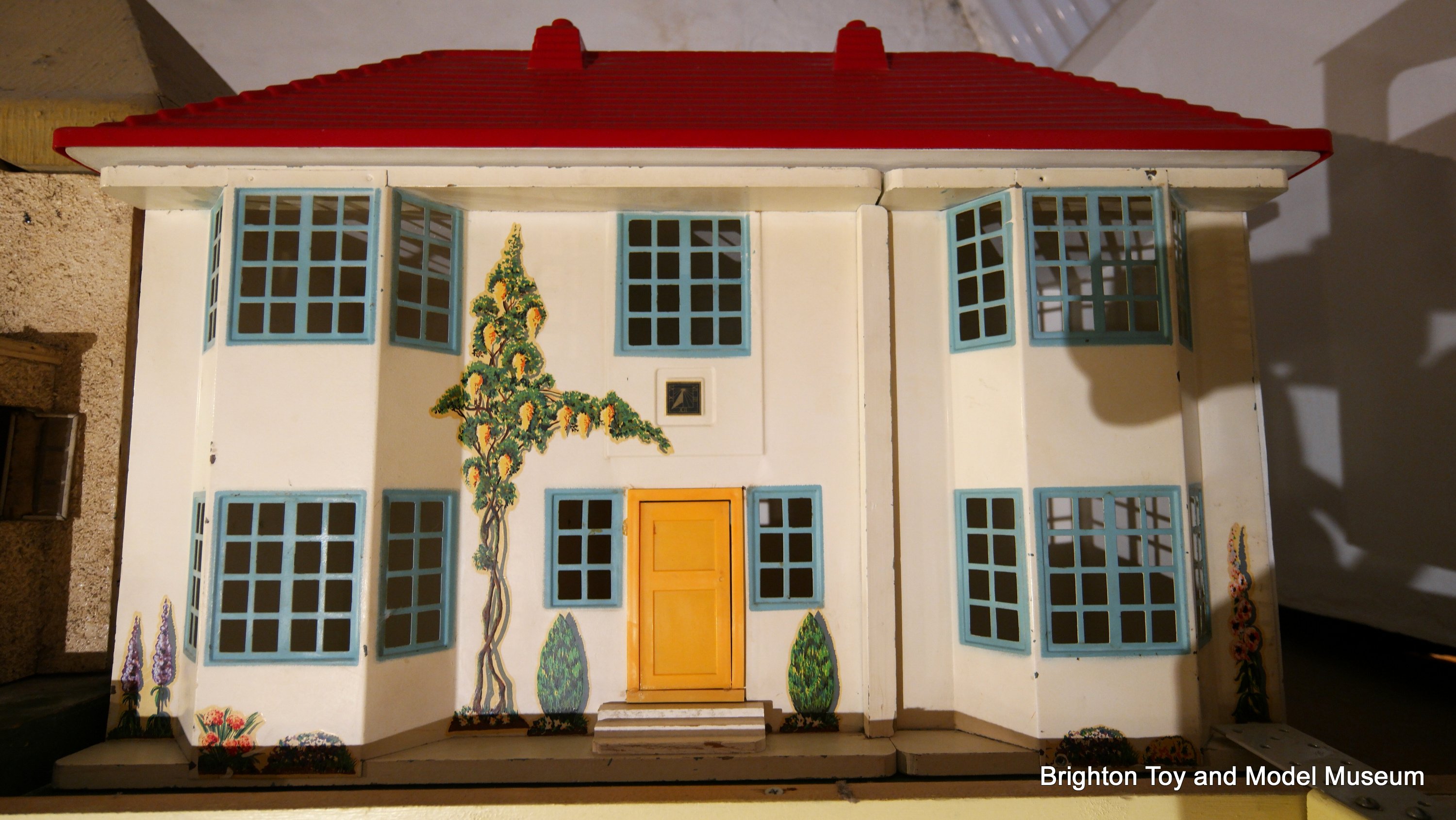
This is the latest addition to our slowly growing range of Triang dollhouses. We’re trying to build up a selective collection that shows each different generation of materials and design.
The No. 65 (produced from 1964-1968) represents an attempt by Lines Brothers to streamline dollhouse production and experiment with new materials and methods – while the wooden body is traditional, the front consists of painted pressed-steel front panels that slide (rather than the more traditional hinged wooden front), and its roof is a slightly delicate (and easily damaged) single-piece plastic moulding.
What we don’t currently have in the museum are any dollhouses by G. and J. Lines. George and Joseph Lines were were a big name in dollhouse (and wooden horse) production spanning the late Nineteenth and early Twentieth Century, and when the two brothers finally died, their business was folded into the breakaway company that had been started by Joseph’s sons Arthur, George, and Walter Lines (Lines Brothers, trademark “Tri-ang“, because “three lines make a triangle”). Although Lines Brothers had already developed a massive product range of their own, they made a point of picking up and continuing the commercial dollhouse-making tradition that had been started by their father and uncle.
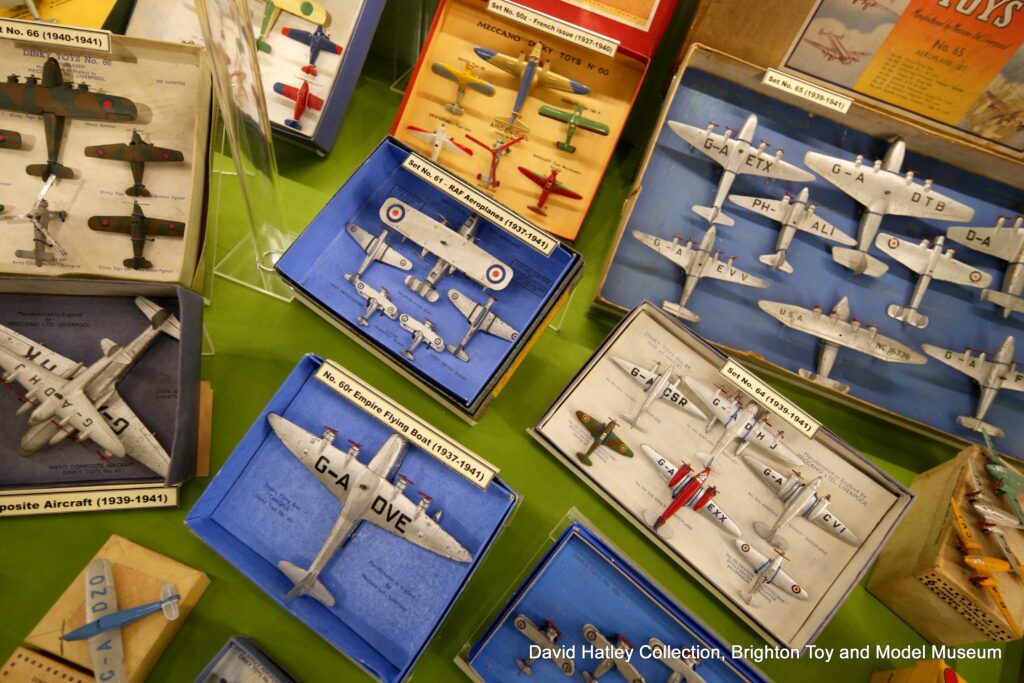
Finally installed and on public display, this outrageous collection of over four hundred early Dinky Toys and lead Hornby Modelled Miniatures represents the range from 1932 up until 1941, and has pretty much everything the company made before the closedown of production in World War Two (but not necessarily in every single colour variation!).
The pre-WW2 Dinky range consisted of over three hundred different designs, many of which never reappeared after the war. Where the immediately post-war range of road vehicles adopted the muted colours of real vehicles of the 1940s and 1950s, the pre-war range were often eyecatchingly brightly-coloured. Because of the problems that Meccano Ltd. initially had using the new MAZAK diecasting alloy, much of the pre-war production was prone to eventual warping, cracking and even complete disintegration, so comparatively few examples have survived in good condition.
Incredibly, most of the collection is accompanied by original trade retail boxes.

While we’re waiting for the 1930s Dinky display to be finished, we’ve upgraded the adjacent display of Dinky Toys from the 1940s and 1950s. As well as a number of new additions (taking the total to over 180), we’ve been testing a new labelling system: The front of each tilted glass shelf now has a thin strip of shiny tinplated steel along the front, and the labels have magnetic backings so that it’s easier for us to move things around.
We also have a set of laminated catalogue pages for visitors to browse through.
Space is always an issue in the museum. What’s currently missing is the Dinky Army range. We have a complete set of this in storage, but it was moved off-display to make space, and was meant to be installed in a new end cabinet that has now been earmarked for something else. We’ll think of a way of displayng it eventually.
The Museum’s continual policy of improvement means that we very rarely go a full month without having something new on display. However for the first half of 2022, all our display efforts are instead being directed towards a push to get the David Hatley Dinky Collection on display.
This is turning out to be a huge job, from initially sorting, photographing and inventorying the collection, to measuring-up and assessment. The combination of possible box angles and box lid heights and layouts makes this equivalent to having to solve a hugely complex three-dimensional jigsaw puzzle with a lot of variables, before we can even decide what sizes of glass shelves to have cut, and where to put them.
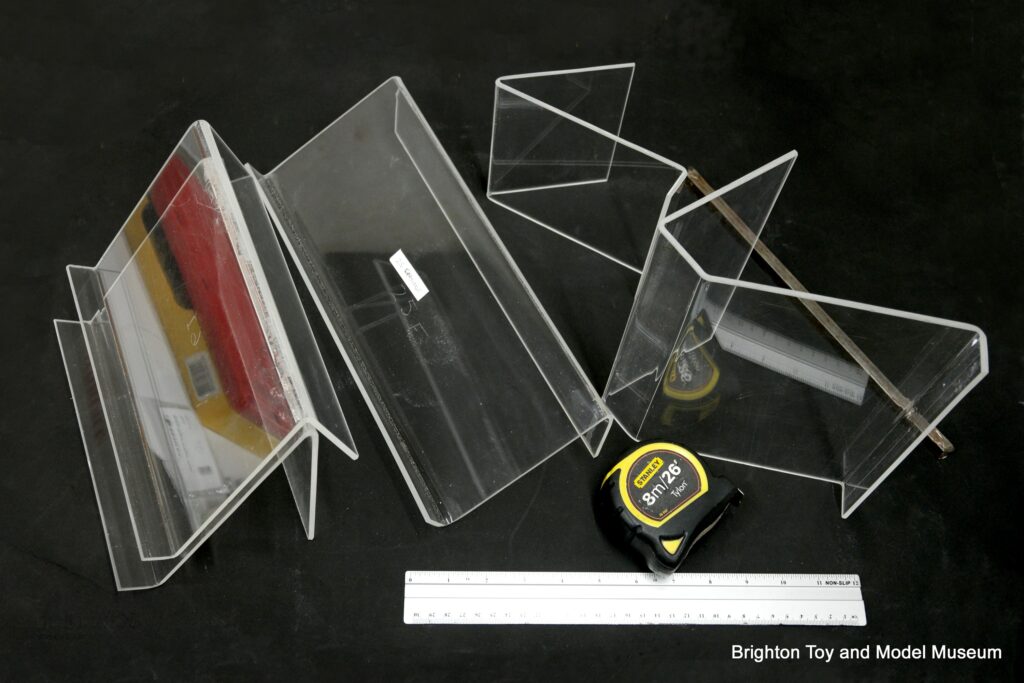
Shelving is supported by clear acrylic columns, and each box sits on its own individual clear acrylic stand custom-fabricated in our workshop (which the visitor will hopefully never notice). The overall effect is designed to be reminiscent of an old-fashioned toy shop window, complete with two custom-designed revolving double-layer display stands showcasing the Collection’s horribly rare Hornby Modelled Miniatures lead vehicles.
The display will be unveiled to the public on Wednesday 6th July 2022.
The Second of April saw the Mayor launch Trafalgar Street’s new “wayfaring” makeover, designed to help the street establish a more unified identity and reposition Trafalgar Street in the minds of visitors coming from the station as the default gateway to the North Laine.
The wayfaring includes brightly coloured vinyl wraps for bollards and other similar street furniture, flags, and a bright blue fairground-style “North Laine” mural painted on one side of the top of Trafalgar Street.
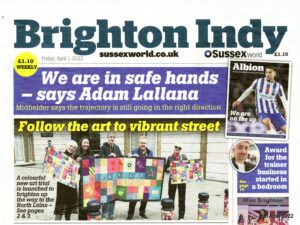
The mural was designed and painted by local artist Dave Pop, the other wayfaring was designed by Richard Wolfströme and fabricated by Lollipop Print, and the project was co-ordinated with the other Trafalgar Street traders by Jan Etches, the museum’s General Manager. The project was paid for by the UK Government’s Welcome Back Fund, created as a “kickstart” initiative to to encourage shoppers to rediscover their high streets after COVID, which was in turn funded by residual money from the EU’s European Regional Development Fund (ERDF).
This is probably the first time that the street’s businesses have come together on a project like this, and we hope that this will only be the first of many fruitful future collaborations.
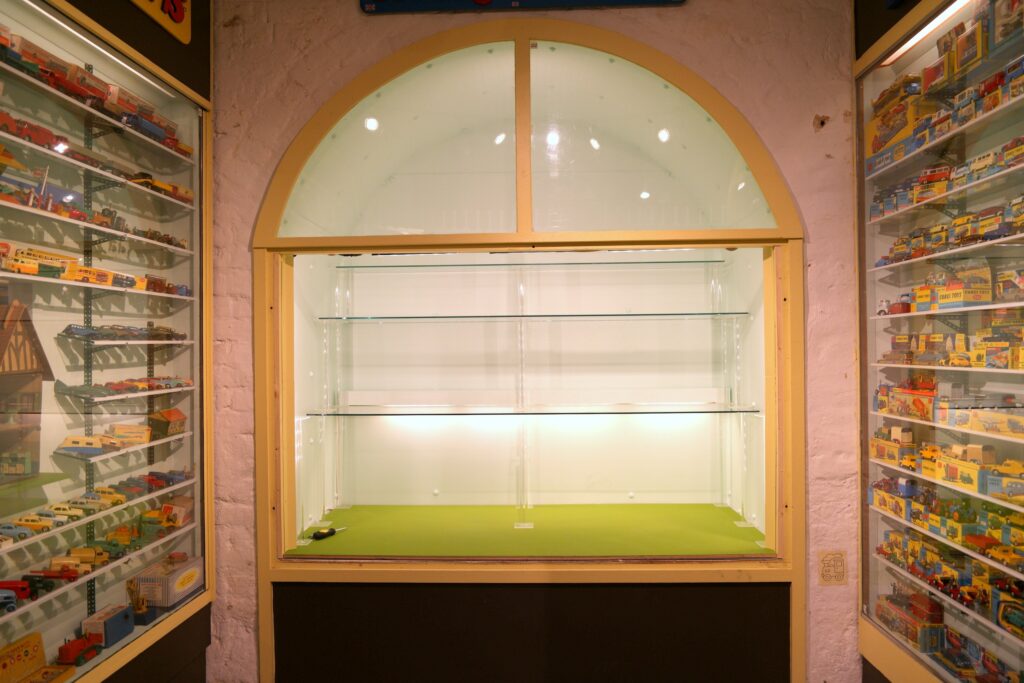
Area 22 hs now been cleaned, scrubbed, aired, water-sealed and fitted with a waterproof cladding.
It has also been painted, shelved, and lit, and is now almost ready to be inhabited by the wonderful David Hatley Collection of early Dinky Toys.
The unique guest collection of Tri-ang “Spot On” models (featured on the back cover of “The Ultimate Book of Spot On Models Ltd.“) has been cycled off display for the time being.
Display Space 22 is in need of a maintenance overhaul, which requires the collection to be put into temporary storage. We were wanting to redesign the display anyway, so now the plan is to design and build a new dedicated display space somewhere else in the museum to house it.

We now have all three of the 1939 premium Trix Twin Railway presentation sets on display, side-by-side: the Royal Scot, the Flying Scotsman, and the US Tour 1939 Coronation Scot.
The special Coronation Scot US Tour streamliner train is a wistfully poignant historical piece … the real train was intended to be the prototype for the future of high-speed ultra-luxury travel in the UK, with the first completed train shipped off to the US on a goodwill and publicity tour, and fitted with a bell and headlight to conform to US regulations. With the outbreak of WW2 in late 1939, the train was left stranded in the US, and the project was abandoned. After the war, the British railway network was no longer capable of taking high-speed trains, and post-war austerity meant that luxury travel was no longer a national priority.
This left Trix with stock of expensive models of a train that would never carry a single paying UK passenger.